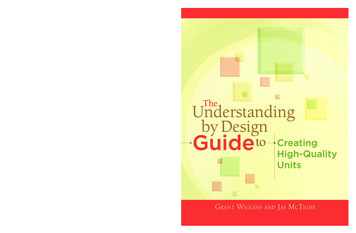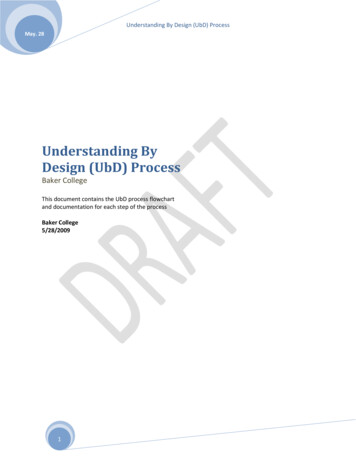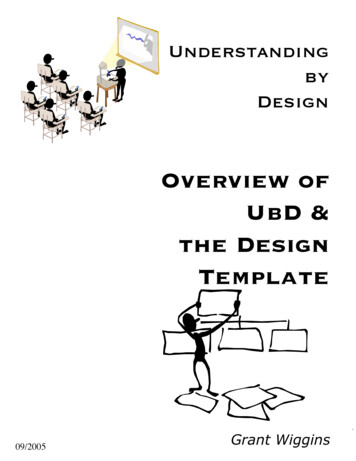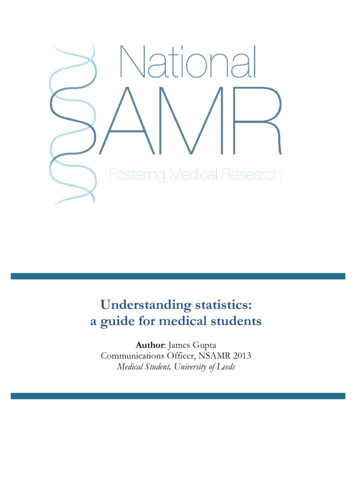
Transcription
The Understanding by Design Guide to Creating High-Quality Unitsoffers instructional modules on the basic concepts and elements ofUnderstanding by Design (UbD), the “backward design” approachused by thousands of educators to create curriculum units andassessments that focus on developing students’ understanding ofimportant ideas. The eight modules are organized around the UbDTemplate, version 2.0, and feature components similar to what istypically provided in a UbD design workshop, includingn Discussion and explanation of key ideas in the module;n Guiding exercises, worksheets, and design tips;n Examples of unit designs;n Review criteria with prompts for self-assessment; andn A list of resources for further information.This guide is intended for K–16 educators—either individualsor groups—who may have received some training in UbD andwant to continue their work independently; those who’ve readUnderstanding by Design and want to design curriculum units buthave no access to formal training; graduate and undergraduatestudents in university curriculum courses; and school and districtadministrators, curriculum directors, and others who facilitate UbDwork with staff. Users can go through the modules in sequence orskip around, depending on their previous experience with UbDand their preferred curriculum design style or approach. Unitcreation, planning, and adaptation are easier than ever with theaccompanying downloadable resources, including the UbD templateset up as a fillable PDF form, additional worksheets, examples,and FAQs about the module topics that speak to UbD novices andveterans alike.UbDGuide1 CreatingUnits Cvr.indd 1 26.95 U.S.2/15/11 9:11 AM
The Understanding by DesignGuide toCreating High-Quality Unitsđđđđđ
Other ASCD booksby Grant Wiggins and Jay McTigheSchooling by Design: Mission, Action, and AchievementUnderstanding by Design Professional Development WorkbookUnderstanding by Design Expanded 2nd Edition
Alexandria, Virginia USA
1703 N. Beauregard St. Alexandria, VA 22311-1714 USAPhone: 800-933-2723 or 703-578-9600 Fax: 703-575-5400Website: www.ascd.org E-mail: member@ascd.orgAuthor guidelines: www.ascd.org/writeGene R. Carter, Executive Director; Judy Zimny, Chief Program Development Officer; Nancy Modrak, Publisher;Scott Willis, Director, Book Acquisitions & Development; Julie Houtz, Director, Book Editing & Production;Darcie Russell, Editor; Georgia Park, Senior Graphic Designer; Mike Kalyan, Production Manager; ValerieYounkin, Desktop Publishing Specialist; Sarah Plumb, Production Specialist 2011 by Grant Wiggins and Jay McTighe. All rights reserved. No part of this publication may be reproduced or transmitted in any form or by any means, electronic or mechanical, including photocopy,recording, or any information storage and retrieval system, without permission from ASCD. Readers whowish to duplicate material copyrighted by ASCD may do so for a small fee by contacting the CopyrightClearance Center (CCC), 222 Rosewood Dr., Danvers, MA 01923, USA (phone: 978-750-8400; fax: 978646-8600; web: www.copyright.com). For requests to reprint rather than photocopy, contact ASCD’s permissions office: 703-575-5749 or permissions@ascd.org. Translation inquiries: translations@ascd.org.Understanding by Design and UbD are trademarks of the Association for Supervision and Curriculum Development. ASCD EDge is a trademark of the Association for Supervision and CurriculumDevelopment.Printed in the United States of America. Cover art 2011 by ASCD. ASCD publications present a varietyof viewpoints. The views expressed or implied in this book should not be interpreted as official positionsof the Association.All web links in this book are correct as of the publication date below but may have become inactive orotherwise modified since that time. If you notice a deactivated or changed link, please e-mail books@ascd.org with the words “Link Update” in the subject line. In your message, please specify the web link,the book title, and the page number on which the link appears.PAPERBACK ISBN: 978-1-4166-1149-3ASCD product 109107n3/11Also available as an e-book (see Books in Print for the ISBNs).Quantity discounts for the paperback edition only: 10–49 copies, 10%; 50 copies, 15%; for 1,000 ormore copies, call 800-933-2723, ext. 5634, or 703-575-5634. For desk copies: member@ascd.org.Library of Congress Cataloging-in-Publication DataWiggins, Grant P., 1950–The understanding by design guide to creating high-quality units / Grant Wiggins and Jay McTighe.p. cm.ISBN 978-1-4166-1149-3 (pbk. : alk. paper) 1. Curriculum planning—United States. 2. Curriculumbased assessment—United States. 3. Learning. 4. Comprehension. I. McTighe, Jay. II. Title.LB2806.15.W545 2011375'.001—dc22201004116021 20 19 18 17 16 15 14 13 12 111 2 3 4 5 6 7 8 9 10 11 12
The Understanding by DesignGuide toCreating High-Quality Units List of Figures .viIntroduction . 1Module A: The Big Ideas of UbD . 3Module B: The UbD Template. 13Module C: Starting Points . 33Module D: Developing an Initial Unit Sketch. 42Module E: Different Types of Learning Goals . 57Module F: Essential Questions and Understandings . 70Module G: Determining Evidence of Understanding andDeveloping Assessment Tasks . 89Module H: Learning for Understanding . 102Afterword . 120About the Authors . 121
List of FiguresThe figures critical to exploring Understanding by Design are printed within andpage numbers are supplied. Additional figures that may be helpful are availableonline and are noted with the OO designation. All figures may be downloadedfor your convenience.Introduction1Outline of Modules . 1Module AA.1A.2A.3A.4A.5A.6The Logic of Backward Design . 9UbD in a Nutshell . OOWhat Is “Understanding”? . OOWhat Is “Understanding” of Specific Topics? . OOThe Best Designs for Learning. OOThinking About “Understanding” . OOModule 15The UbD Template, Version 2.0 . 16Driver’s Education Unit . 18Unpacking Standards for Stage 1 . 23Unit Design Standards . 27Social Studies Unit Before UbD. 28Social Studies Unit . 29Algebra Unit Before UbD . OOAlgebra Unit . OOMusic Unit . OOLiterature Unit . OOClimate Unit . OOVisual Arts Unit. OOHealth and PE Unit . OOHistory Unit . OOTime Unit . OOModule CC.1C.2C.3Starting Points in Unit Design . 36Common Problem Statements . 38Various Template Entry Points .41
C.4C.5C.6C.7C.8C.9C.10Entry Point—Content Standards . OOEntry Point—Important Topic . OOEntry Point—Important Skill . OOEntry Point—A Key Text . OOEntry Point—A Favorite Activity . OOEntry Point—A Key Test . OOUsing the Textbook Wisely. OOModule DD.1D.2D.3D.4Simple Stages for Nutrition Unit . 44Simple Stages Template . OO“If . . ., Then” Worksheet. OOWhat’s the Point of My Unit?. OOModule EE.1E.2E.3E.4E.5E.6E.7E.8E.9E.10E.11E.12Examples of Four Goal Types. 60Distinguishing Understandings from Factual Knowledge . 63Successful Meaning-Making . 64Examples of Transfer Goals . 67Nutrition Unit Outline for Stage 1 . 68Summarize the Relationships Among Four Goal Types . OOCoding Stage 1 Goals . OOImplications for Stages 2 and 3 of Four Goal Types . OOSample Implications for Stages 2 and 3 of Four Goal Types . OOClarifying Transfer Goals . OOConsidering Long-Term Transfer Goals. OOClarifying Meaning Goals . OOModule FF.1F.2F.3F.4F.5F.6F.7F.8Distinguishing Essential Questions from Knowledge Questions . 77Essential Questions for Skill-Related Goals .81What Makes a Question “Essential”? . 82Framing Understandings. 86Nutrition Unit with Expanded Understandingsand Essential Questions . 88Brainstorming Big Ideas . OOBrainstorming Essential Questions . OOFrom Topics to Big Ideas . OO
F.9F.10F.11F.12F.13Manifestations of Big Ideas . OOFinding the Big Ideas in Skills. OOExample of Essential Questions in Skill Areas . OOIdentifying Understandings . OOFrom Skills to Ideas to Understandings . OOModule GG.1G.2G.3G.4G.5G.6G.7G.8G.9Applying the Two-Question Validity Test .91Performance Task Ideas Based on the Six Facets . 95Generating Assessment Ideas Using the Facets . 97Six-Facet Question Starters . 99Performance Verbs Related to the Six Facets of Understanding . 100Brainstorming Tasks Using the Six Facets.101Developing Assessment Ideas Using the Six Facets . OOWhat My Transfer Goals Imply for Tasks . OOAnalyzing Textbooks and Instructional Resources . OOModule HH.1H.2H.3H.4H.5H.6H.7A-M-T Learning Goals and Teaching Roles. 105Action Verbs for A-M-T . 106Coding Learning Events Using A-M-T .107A-M-T for a Unit on Measures of Central Tendency .112Nutrition Unit, Stage 3: Coded Learning Events Using A-M-T .119Learning for Understanding (A-M-T) . OOUsing the Textbook Wisely. OO
Downloads/Key PageThe figures in this book, as well as additional worksheets and examples,are available for download at www.ascd.org/downloadsEnter this unique key code to unlock the files:G1659 0E67D 0AB10If you have difficulty accessing the files, e-mail webhelp@ascd.org or call1-800-933-ASCD for assistance.
IntroductionThe Understanding by Design Guide to Creating High-Quality Units is targeted to individuals and groups interested in improving their skills in designing units of studybased on the Understanding by Design (UbD) framework. This guide introducesUbD unit design and directs readers through the process. It is organized arounda set of modules that move from basic ideas (e.g., the three stages of “backwarddesign”) to more complicated elements of unit design (e.g., authentic performancetasks). Figure 1 shows a graphic representation of the organization of the modules.Each module includes the following components: Narrative discussion of key ideas in the moduleGuiding exercises, worksheets, and design tips for unit designAn example of an emerging designReview criteria (design standards) with prompts for self-assessmentA list of resources for further informationFigu re 1Outline of ModulesStage 1—Desired ResultsStage 2—EvidenceStage 3—Learning PlanModule A: The Big Ideas of UbDModule B: The UbD TemplateModule C: Starting PointsModule D: Developing an Initial Unit SketchModule E: Different Types ofLearning GoalsModule F: Essential Questionsand UnderstandingsModule H: Learning for Understanding1Module G: Determining Evidenceof Understanding and DevelopingAssessment Tasks
2The Und er stand ing b y Design G ui de t o Cre at i ng Hi gh-Q ual i t y Uni t sIn addition to the print format, the Guide to Creating High-Quality Units featuresonline resources correlated to the text. Many of the exercises and worksheets areaccessible as downloads in electronic form, as are additional unit examples. Theonline portion includes frequently asked questions (FAQs) and will allow updates(e.g., more unit examples and new resources) to be readily accessed.We invite users, especially beginners, to complete the exercises and worksheets to assist them in thinking through the unit design process. However, it isimportant to always keep the end—a coherent and well-aligned unit plan—inmind. If you find one or more exercises and worksheets unnecessary, feel free toskip them. Also, think of the exercises and worksheets as being like the trainingwheels on a bicycle. Eventually you’ll find that you no longer need them as yourunderstanding of UbD deepens and your unit design skills become more effectiveand automatic.The modular presentation of this material means that users need not followthe modules in the order presented. As you can see from Figure 1, the volume isorganized by the logic of the three stages of backward design. This logic should notbe confused with a directive about the (inherently messy) process of design. Yourinterests, strengths, and prior experience as a designer will inevitably dictate howyou use this book and the sequence you follow.Think of this guide, then, as a cookbook. A cookbook has chapters devotedfirst to recipes for appetizers, then for soups and salads, then for fish and meat,vegetables, and desserts. Similarly, the Guide to Creating High-Quality Units is organized by the “menu” of a unit’s parts—the elements of the unit template. Butalthough the cookbook is organized, you need not read it from cover to cover ormake all the recipes in the order in which they appear. So, too, in unit design. Likethe recipe creator, you’ll find that your path is informed by the need to put the finalwork in a certain form, but creation is inherently more nonlinear as you try thingsout, alter various “ingredients,” and double-back to ensure that the end productworks.If you want more information on available products related to Understanding by Design, consult www.ascd.org. A community of people interested in UbDand additional resources are on ASCD EDge, accessible at tanding-by-design/. ASCD EDge is a professional networking community for educators.
Module AThe Big Ideas of UbDPurpose: To become acquainted with the big ideas of Understanding by Design.Desired Results: Unit designers will understand that Understanding by Design (UbD) is a curriculum-planning framework, not a prescriptiveprogram. UbD focuses on helping students come to an understanding of important ideas andtransfer their learning to new situations. UbD reflects current research on learning.You should work on Module A if you are new to Understanding by Design.You might skim or skip Module A if you are familiar with the basic ideas of UbD.As its title suggests, Understanding by Design (UbD) reflects the convergence of twointerdependent ideas: (1) research on learning and cognition that highlights thecentrality of teaching and assessing for understanding, and (2) a helpful and timehonored process for curriculum writing (Wiggins & McTighe, 2005).UbD is based on eight key tenets:1. UbD is a way of thinking purposefully about curricular planning, not arigid program or prescriptive recipe.2. A primary goal of UbD is developing and deepening student understanding—the ability to make meaning of learning via “big ideas” and to transferlearning.3. UbD unpacks and transforms content standards and mission-related goalsinto relevant Stage 1 elements and appropriate assessments in Stage 2.4. Understanding is revealed when students autonomously make senseof and transfer their learning through authentic performance. Six facets of3
4The Und er stand ing b y Design G ui de t o Cre at i ng Hi gh-Q ual i t y Uni t sunderstanding—the capacities to explain, interpret, apply, shift perspective, empathize,and self-assess—serve as indicators of understanding.5. Effective curriculum is planned “backward” from long-term desired resultsthrough a three-stage design process (Desired Results, Evidence, Learning Plan).This process helps to avoid the twin problems of “textbook coverage” and “activityoriented teaching” in which no clear priorities and purposes are apparent.6. Teachers are coaches of understanding, not mere purveyors of content oractivity. They focus on ensuring learning, not just teaching (and assuming that whatwas taught was learned); they always aim—and check—for successful meaningmaking and transfer by the learner.7. Regular reviews of units and curriculum against design standards enhancecurricular quality and effectiveness.8. UbD reflects a continuous-improvement approach to achievement. Theresults of our designs—student performance—inform needed adjustments in curriculum as well as instruction; we must stop, analyze, and adjust as needed, on aregular basis.In this module, we’ll explore two of the big ideas of UbD—understanding and design.Understanding as an Educational AimThe header for this section may strike readers as unnecessary. Don’t all teacherswant their students to understand what they teach? Perhaps. But an examinationof many classrooms reveals that instruction is often focused on superficial coverage of lots of content as specified by national, state, or provincial standards, or ascontained in distended textbooks. Even in nominally successful classrooms we seean overemphasis on short-term content acquisition for simple recall instead oflong-term understanding. The teaching and learning process is also influenced inunfortunate ways by the pressure associated with high-stakes accountability tests.In many schools, teachers are expected to engage in “test prep” as a means of raising test scores. At its worst, this practice encourages and results in bad teaching—alow-level and formulaic approach to learning at the expense of exploring ideas ingreater depth. Ironically, high-level achievement is actually undercut by such anapproach (Wiggins, 2010).Understanding by Design proposes a sound and commonsense alternative to these prevailing methods. UbD is predicated on the idea that long-termachievement gains are more likely when teachers teach for understanding oftransferable concepts and processes while giving learners multiple opportunities to apply their learning in meaningful (i.e., authentic) contexts. The requisite knowledge and skills are learned and long recalled through the process ofactively constructing meaning (i.e., coming to an understanding) and in transferring learning to new situations. In short, when we treat content mastery as the
M odul e A: The Bi g Ide as o f U b Dmeans, not the end, students learn more in the long term and can become moreengaged in their work.Support for an understanding-based approach to instruction and classroomassessment comes from research in cognitive psychology and neurology. The bookHow People Learn: Brain, Mind, Experience, and School (Bransford, Brown, & Cocking, 2000) provides a readable synthesis of the psychological research. Here arebrief summaries of several key findings that provide a conceptual base for UbD’sspecific instruction and assessment practices: Effective learning requires not an exclusive focus on diligent drill and practice but rather a balanced focus on students’ understanding and application of knowledge along with drill—much like what all good coaches doon the field or on the stage. Transfer requires learning strategy and alternate “moves” in all fields. To be widely applicable, learning must be guided by generalized principles.Knowledge learned at the level of rote memory rarely transfers; transfermost likely occurs when the learner understands underlying concepts andprinciples that can be applied to problems in new contexts. Learning withunderstanding is far more likely to promote transfer than simply memorizing information from a text or a lecture. Experts first seek to develop an understanding of problems or challenges,and this often involves thinking in terms of core concepts or big ideas (e.g.,schemas, themes, models, theories, etc.). Novices’ knowledge is muchless likely to be organized around big ideas; novices are more likely toapproach problems by searching for correct formulas and pat answers thatfit their everyday intuitions. Research on expertise suggests that superficial coverage of many topics inthe domain is a poor way to help students develop the competencies thatwill prepare them for future learning and work. Curricula that emphasizebreadth of knowledge may prevent effective organization of knowledgebecause not enough time is provided to learn anything in depth. Curricula that are “a mile wide and an inch deep” risk developing disconnectedrather than connected knowledge. Many assessments measure only recently taught knowledge and never askfor authentic performance (conditional knowledge and skill in context)—whether students know when, where, and why to use what they have learnedin the past. This approach leads to surprisingly poor test results, becausestudents do not recognize prior learning in unfamiliar-looking test questions—especially when the test has no context clues and hints (as occurswhen teachers immediately quiz students on recent material.) Given thatperformance is the goal, local assessments typically do not provide a validmeasure of student understanding.5
6The Und er stand ing b y Design G ui de t o Cre at i ng Hi gh-Q ual i t y Uni t sAdditional validation of the principles and practices of Understanding by Designcomes from the emerging research on the neuroscience of learning (see, e.g., Willingham, 2009). Judy Willis (2006), a licensed neurologist and middle schoolteacher, notes the following instructional implications of this research: Patterning is the process whereby the brain perceives and generates patternsby relating new with previously learned material or chunking material intopatterns it has not used before. Whenever new material is presented insuch a way that students see relationships, they generate greater brain cellactivity (forming new neural connections) and achieve more successfullong-term memory storage and retrieval. Experiential learning that stimulates multiple senses in students, such ashands-on science activities, is not only the most engaging but also themost likely to be stored as long-term memories. The best-remembered information is learned through multiple and variedexposures followed by authentic use of the knowledge.Research findings such as these provide a conceptual underpinning for Understanding by Design and should guide curriculum and assessment design, as well asinstructional practice.What Is Understanding?The term understanding is surprisingly tricky, even though it is used widely. It hasmany different connotations. In fact, you may be aware that Benjamin Bloom andhis colleagues (1956) avoided using the term in their taxonomy of the cognitivedomain because it was seen as imprecise. Yet the term intuitively stands for something important—and different from content mastery, per se.Therefore, at the start, we invite you to stop and reflect. What is understanding?What do we mean when we say we want students to understand the content, not just knowit? What’s the difference between really “getting it” and just regurgitating back what wastaught?If you are like most people, you identified a few clear yet different meaningsof the term. Some of the meanings tend to be about ideas and inferences (e.g.,making connections, seeing the big picture, grasping core concepts), and sometend to involve effective use of knowledge and skill (e.g., teach others, say it inyour own words, apply learning to a real-world setting, defend your views to anaudience). At this point, we merely note that the term is multifaceted, that understanding is something different from mere “knowing,” and that the goal of understanding therefore involves more sophisticated instruction and assessment thanteaching and testing for knowledge and skill alone. If the goal is understanding, bydesign, we’ll need to plan mindful of these meanings.
M odul e A: The Bi g Ide as o f U b DGood Design “Backward” DesignTeaching is a means to an end, and planning precedes teaching. The most successful teaching begins, therefore, with clarity about desired learning outcomes andabout the evidence that will show that learning has occurred. Understanding byDesign supports this view through a three-stage “backward-design” process used toplan curriculum units that include desired understandings and performance tasksthat require transfer. Specific lessons are then developed in the context of a morecomprehensive unit design.The concept of planning curriculum backward from desired results is notnew. In 1948, Ralph Tyler advocated this approach as an effective process forfocusing instruction; Bloom’s Taxonomy—and its recent revision by Andersonand Krathwohl (2001)—lays out the different types of educational aims and whatthey require of assessment; Robert Gagné (1977) and Robert Mager (1988) havelong taught people how to analyze different outcomes and what they require oflearning; more recently, William Spady (1994) popularized the idea of “designingdown” from exit outcomes.Although not a novel idea, backward design as we frame it results in moreclearly defined and wisely blended short-term and long-term goals, more appropriate assessments, and more purposeful teaching than typical planning
The Understanding by Design Guide to Creating High-Quality Units offers instructional modules on the basic concepts and elements of Understanding by Design (UbD), the “backward design” approach used by thousands of educators to create curriculum units and assessments that focus










